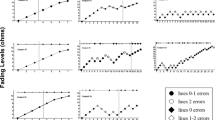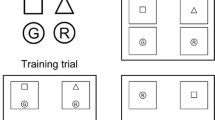Abstract
Fifty-nine children were exposed to one of three discrimination training procedures that might teach them to discriminate a circle from an ellipse. One procedure was an extensively studied, well-validated stimulus control shaping program that used intensity fading procedures. The other two procedures used no fading and relied primarily on simple differential reinforcement of the final performance. The stimulus control shaping program established the circle-ellipse discrimination in 18 of 19 subjects with few or no errors, thus replicating previous research. An unexpected finding was the high success rate of the other two procedures. The circle-ellipse discrimination was established in 36 of 40 subjects. Many of these subjects also learned with few or no errors. In general, the findings demonstrate that extremely rapid (even one-trial) discrimination learning is achievable with very young children without stimulus control shaping. The findings also point to variables that may be important in analysis of learning that occurs in the course of the circle-ellipse stimulus control shaping program.
Similar content being viewed by others
References
BALSAM, P. D. (1988). Selection, representation, and equivalence of controlling stimuli. In R. C. Atkinson, R. J. Herrnstein, G. Lindzey, & R. D. Luce (Eds.), Stevens’ handbook of experimental psychology, Volume 1: Perception and motivation (pp. 111–166). New York: Wiley & Sons.
BONEAU, C. A., & HONIG, W. K. (1964). Opposed generalization gradients based upon conditional discrimination training. Journal of Experimental Psychology 66, 89–93.
DUBE, W. V., MCILVANE, W. J., & GREEN, G. (1992). An analysis of generalized identity matching-to-sample test procedures. The Psychological Record, 42, 17–28.
HARLOW, H. F. (1949). The formation of learning sets. Psychological Review, 56, 51–65.
HONIG, W. K., & URCUIOLI, P. J. (1981). The legacy of Guttman and Kalish (1956): Twenty-five years of research on stimulus generalization. Journal of the Experimental Analysis of Behavior, 36, 405–445.
KAUFMAN, M. E., & PREHM, H. J. (1966). A review of research on learning sets and transfer of training in mental defectives. In N. R. Ellis (Ed.), International review of research in mental retardation (Vol. 2, pp. 123–149). New York: Academic Press.
MACKINTOSH, N. J. (1977). Stimulus control: Attentional factors. In W. K. Honig & J. E. R. Staddon (Eds.), Handbook of operant behavior (pp. 481–513). Englewood Cliffs, NJ: Prentice-Hall.
MCILVANE, W. J., & DUBE, W. V. (1992). Stimulus control shaping and stimulus control topographies. The Behavior Analyst, 15, 89–94.
PETERSON, N. (1962). Effect of monochromatic rearing on the control of responding by wavelength. Science, 136, 774–775.
RAY, B. A. (1969). Selective attention: The effects of combining stimuli which control incompatible behavior. Journal of the Experimental Analysis of Behavior, 12, 539–550.
RESCORLA, R. A. (1973). Evidence for “unique stimulus” account of configural conditioning. Journal of Comparative and Physiological Psychology, 85, 331–338.
RUDOLPH, R. L., HONIG, W. K., & GERRY, J. E. (1969). Effects of monochromatic rearing on the acquisition of stimulus control. Journal of Comparative and Physiological Psychology, 67, 50–58.
SIDMAN, M., & STODDARD, L. T. (1966). Programming perception and learning for retarded children. In N. R. Ellis (Ed.), International review of research in mental retardation (Vol. 2, pp. 151–208). New York: Academic Press.
SIDMAN, M., & STODDARD, L. T. (1967). The effectiveness of fading in programming a simultaneous form discrimination for retarded children. Journal of the Experimental Analysis of Behavior, 10, 3–15.
STEVENSON, H. W. (1970). Children’s learning. New York: Appleton-Century-Crofts.
STODDARD, L. T., & MCILVANE, W. J. (1989). Generalization after intradimensional discrimination training in 2-year old children. Journal of Experimental Child Psychology, 47, 324–334.
STODDARD, L. T., & SIDMAN, M. (1971). Stimulus control after intradimensional discrimination training. Psychological Reports, 28, 147–157.
TRACY, W. K. (1970). Wavelength generalization and preference in monochromatically reared ducklings. Journal of the Experimental Analysis of Behavior, 13, 163–178.
WILLIAMS, B. A. (1973). The failure of stimulus control after presence-absence discrimination of click-rate. Journal of the Experimental Analysis of Behavior, 20, 23–27.
Author information
Authors and Affiliations
Rights and permissions
About this article
Cite this article
Stoddard, L.T., Serna, R.W. & McIlvane, W.J. A Note on Stimulus Control Shaping and One-Trial Learning in Two- and Three-Year-Old Children. Psychol Rec 44, 289–299 (1994). https://doi.org/10.1007/BF03395135
Published:
Issue Date:
DOI: https://doi.org/10.1007/BF03395135




